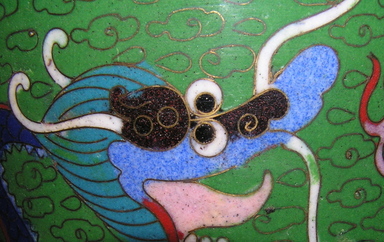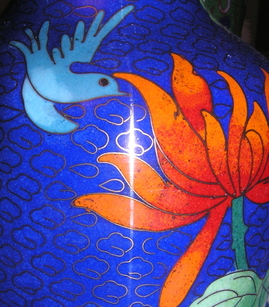|
|
|
| How to Post Photos |
REGISTER (click here)
|
|
|
|
| How to Post Photos |
REGISTER (click here)
|

|
 SMP Silver Salon Forums SMP Silver Salon Forums
  Continental / International Silver Continental / International Silver
  ? Silver Marks on cloisonne salt ? Silver Marks on cloisonne salt
|
| next newest topic | next oldest topic |
| Author | Topic: ? Silver Marks on cloisonne salt |
|
wendlekins Posts: 50 |
  
[26-1029] Hi, I wonder if anyone can help me with these marks on a silver salt? It looks like M in a circle has been stamped several times over a hallmark. I wonder if it is Russian? Many thanks IP: Logged |
|
IJP Posts: 326 |
  
I can't help with identifying these marks, although it does not appear to me that they include any known silver standard marks. I can say, however, that the enameling technique in use here appears to be champlevé rather than cloisonné. From the American Heritage Dictionary: quote: In cloisonné enamelwork, the thread-like filaments are usually very visible, slightly raised above the surface of the enamel itself. Here, the enamel is flush with the surface of the metal, which says to me that the piece was engraved with a design and later filled with enamel in the negative space. IP: Logged |
|
tmockait Posts: 963 |
  
I cannot make sense of the marks either, but the dark spot at the top of your photo looks like base metal beneath what might be silverplate. It could, however, be an illusion created by the photographing. Tom IP: Logged |
|
wendlekins Posts: 50 |
  
Many thanks for your help. The black mark is were it needs cleaning. Thanks for explaining the enameling terms. Very helpful. I was told that the real hallmarks had been obliterated by these stamped marks. But that does seem a little strange. Thanks again IP: Logged |
|
outwest Posts: 390 |
  
When I went to visit my Aunt a few months ago I had a lot of fun looking at all her old silver. She has Victorian plated tea set from 1870-1880 that is quite elaborate. In checking them out I looked at the mark. On every piece the makers mark had been scratched and then stamped over and obliterated by a retailers mark. She said her Grandmother had told her that they were from England and at that time Americans didn't want to buy English silver so much of it had the makers marks scratched out. I have no way of knowing if this story is at all true, but she believed it. I wish I had taken a picture of them. It was quite obvious that it was intentional. IP: Logged |
|
outwest Posts: 390 |
  
Here are two examples of Cloisonne:
 and this one is brass from mid 20th(?):  There was cloisonne produced by the Japanese with silver wires, but the Chinese never used silver. IP: Logged |
|
sazikov2000 Posts: 254 |
  
outwest - please read again what ILP wrote and tried to explain as exact and understandable as possible! The technic used in your fotos is CHAMPLEVÉ not CLOISONNÉ. sazikov 2000 IP: Logged |
|
dragonflywink Posts: 993 |
  
Quite sure that outwest understood IJP's post, her examples appear to be classic Chinese cloisonne and she was illustrating the difference from wendlekin's champleve piece. Here is a detail of Japanese cloisonne with akusake (pigeon blood) enamel, from a pair of 1920s-30s lamps I used to own. Would have to say, having mostly experience with Oriental cloisonne, that they are usually buffed smooth and the wires are at the same level as the enamel. Seems to me that champleve sometimes has a slightly hollowed effect, like there wasn't quite enough enamel to fill the depression Cheryl IP: Logged |
|
outwest Posts: 390 |
  
No, Sazikov, mine are classic Chinese Cloisonne - see the wires? As dragon said, I was trying to show how they are different. Please read IJP's post again.  Your Japanese piece is nice. You'll see that the flowers on that are done with wires, also. That makes it Cloisonne. Also, Japanese enamels were sometimes translucent, but Chinese never are. The piece that started the post appears to have translucent enamel. It would be nice if someone had an example of Japanese silver cloisonne to share. I know they made it, but I haven't seen it. [This message has been edited by outwest (edited 05-03-2006).] IP: Logged |
|
sazikov2000 Posts: 254 |
  
Sorry outwest! My mistake! Japanese CLOISONNÉ is very different from European CLOISONNÉ. The wires seem not to be soldered to the base material one by one but fabricated through some galvanic process, filled with enamel and than grinded plain. Very near to the CHAMPLEVÉ technic. Sorry again! sazikov2000 IP: Logged |
|
dragonflywink Posts: 993 |
  
Watched some Chinese cloisonne artists working at an exhibit at Epcot many years ago, the wires were shaped individually and soldered to the base one by one. Most pieces were buffed smooth, others were left with the wires raised. Understand that some recent pieces are being made now with the wires fabricated onto a fine mesh and the sheet then applied to the base piece before enameling. On the Japanese akusake piece (similar items were fairly common, most date from the late 1800s into the 1930s), the cloisonne work is usually referred to as silverwire, and the rims and wires on my lamps were of a silvery tone, but appeared to be nickel silver. The pigeon blood enamel is very rich and done over a textured base including a bamboo design on the back. Cheryl IP: Logged |
|
wendlekins Posts: 50 |
  
Thank you all for your pictures and information . Does anyone have any idea where my salt could be from ?? Wendy IP: Logged |
All times are ET | next newest topic | next oldest topic |
  |
|
Ultimate Bulletin Board 5.46a
|
1. Public Silver Forums (open Free membership) - anyone with a valid e-mail address may register. Once you have received your Silver Salon Forum password, and then if you abide by the Silver Salon Forum Guidelines, you may start a thread or post a reply in the New Members' Forum. New Members who show a continued willingness to participate, to completely read and abide by the Guidelines will be allowed to post to the Member Public Forums. 2. Private Silver Salon Forums (invitational or $ donation membership) - The Private Silver Salon Forums require registration and special authorization to view, search, start a thread or to post a reply. Special authorization can be obtained in one of several ways: by Invitation; Annual $ Donation; or via Special Limited Membership. For more details click here (under development). 3. Administrative/Special Private Forums (special membership required) - These forums are reserved for special subjects or administrative discussion. These forums are not open to the public and require special authorization to view or post. |
|
copyright © 1993 - 2022
SM Publications
All Rights Reserved. Legal & Privacy Notices |